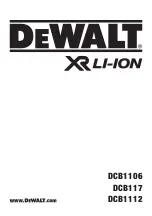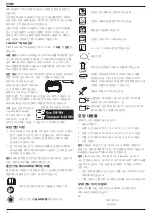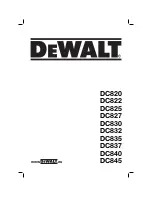
4
English
over, or otherwise subjected to
damage or stress.
•
Do not use an extension cord unless
it is absolutely necessary.
Use of
improper extension cord could result in
risk of fire, electric shock, or electrocution.
•
Do not place any object on top of
charger or place the charger on
a soft surface that might block
the ventilation slots and result in
excessive internal heat.
Place the
charger in a position away from any
heat source. The charger is ventilated
through slots in the top and the bottom
of the housing.
•
Take care to ensure that the charger
is standing in a steady, secure
position.
A falling battery or charger
may present a risk of injury to yourself
and/or others.
•
The location at which the charger is
used should be clean and dry.
Use in a
dirt or wet area could result in risk of fire,
electric shock, or electrocution.
•
Disconnect the charger from the
outlet before attempting any
cleaning.
This will reduce the risk of
electric shock. Removing the battery pack
will not reduce this risk.
•
Do not disassemble charger; take
it to an authorised service centre
when service or repair is required.
Incorrect reassembly may result in a risk
of electrical shock, electrocution or fire.
•
Do not operate charger if it has
received a sharp blow, been dropped,
or otherwise damaged in any way.
Take it to an authorised service centre.
Chargers
D
e
WALT
chargers require no adjustment and are designed to be
as easy as possible to operate.
Electrical Safety
The charger has been designed for one voltage only. Always
check that the battery pack voltage corresponds to the voltage
on the rating plate. Also make sure that the voltage of your
charger corresponds to that of your mains.
Your
D
e
WALT
charger is double insulated in
accordance with IEC60335; therefore no earth wire
is required.
If the supply cord is damaged, it must be replaced only by
D
e
WALT
or an authorised service organisation.
WARNING:
We recommend the use of a residual current
device with a residual current rating of 30mA or less.
Using an Extension Cable
An extension cord should not be used unless absolutely
necessary. Use an approved extension cable suitable for
the power input of your charger (see
Technical Data
). The
minimum conductor size is 1 mm
2
; the maximum length
is 30 m.
When using a cable reel, always unwind the cable completely.
Battery Packs
Important Safety Instructions for All Battery
Packs
When ordering replacement battery packs, be sure to include
catalogue number and voltage.
The battery pack is not fully charged out of the carton. Before
using the battery pack and charger, read the safety instructions
below. Then follow charging procedures outlined.
READ ALL INSTRUCTIONS
•
Do not charge or use battery in explosive atmospheres,
such as in the presence of flammable liquids, gases or
dust.
Inserting or removing the battery from the charger may
ignite the dust or fumes.
•
Never force battery pack into charger. Do not modify
battery pack in any way to fit into a non-compatible
charger as battery pack may rupture causing serious
personal injury.
• Charge the battery packs only in
D
e
WALT
chargers.
•
DO NOT
splash or immerse in water or other liquids.
•
Do not store or use the tool and battery pack in locations
where the temperature may fall below 4 ˚C (34 ˚F) (such
as outside sheds or metal buildings in winter), or reach
or exceed 40 ˚C (104 ˚F) (such as outside sheds or metal
buildings in summer).
•
Do not incinerate the battery pack even if it is severely
damaged or is completely worn out.
The battery pack can
explode in a fire. Toxic fumes and materials are created when
lithium-ion battery packs are burned.
•
If battery contents come into contact with the skin,
immediately wash area with mild soap and water.
If






































